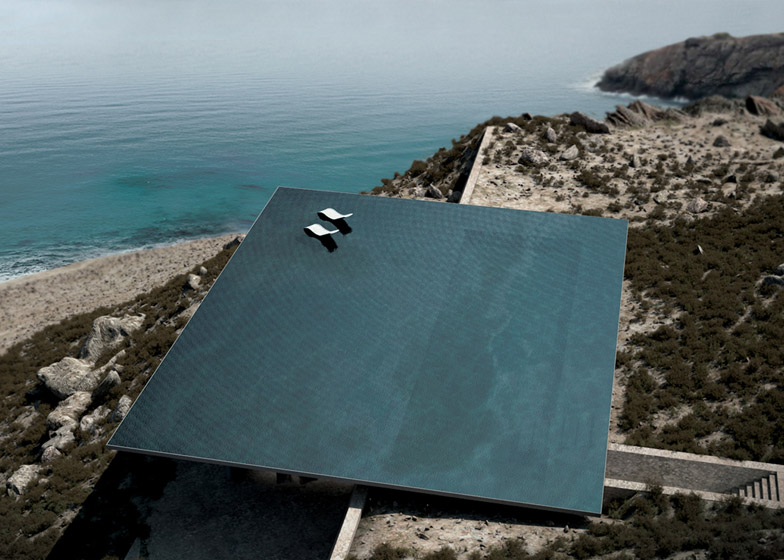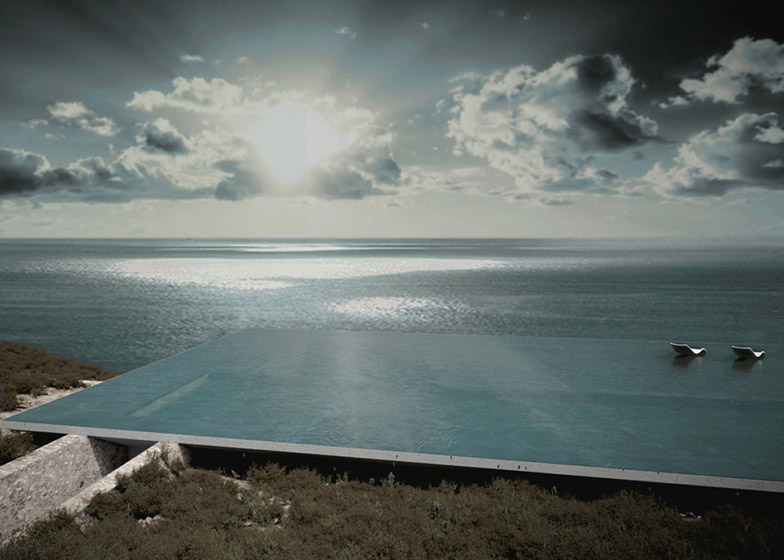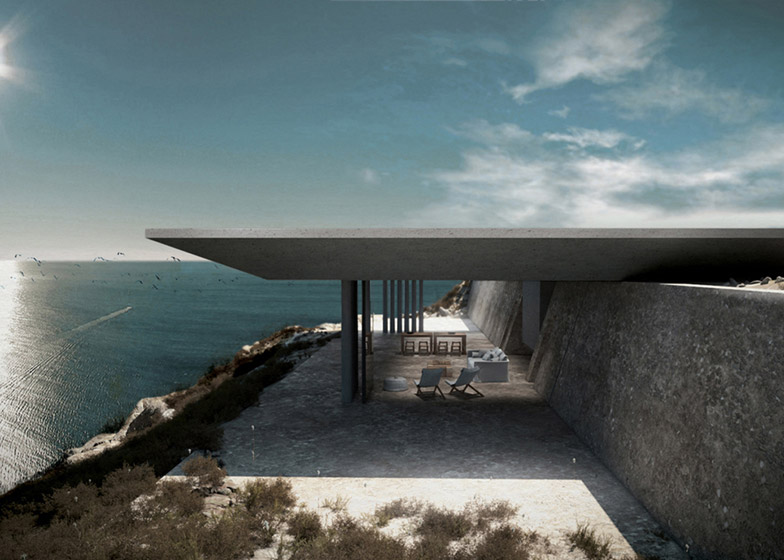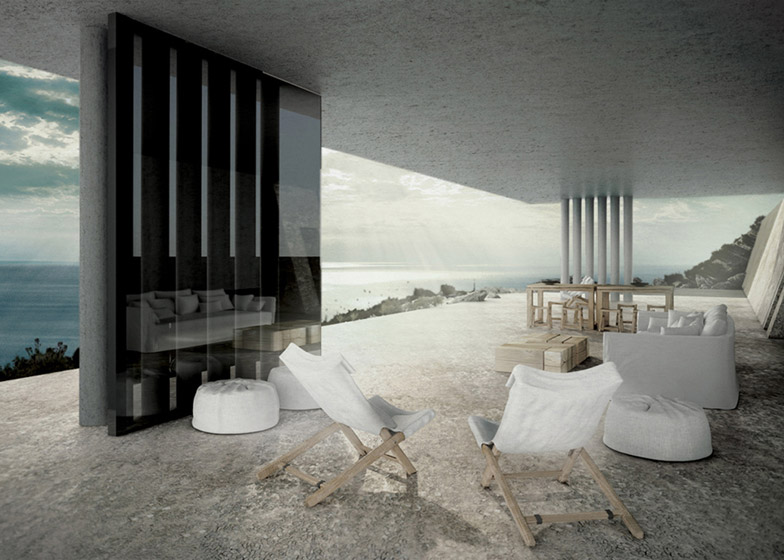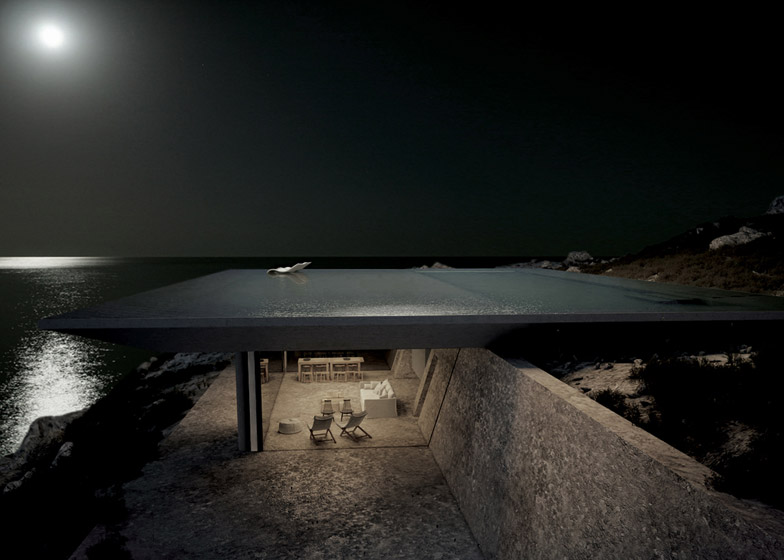An infinity pool will form the roof of this cavernous house designed by Athens studio Kois Associated Architects for the Greek island of Tinos (+ slideshow).
Designed for the rocky terrain that makes up the island's south-west coastline, the Mirage house is conceived by Kois Associated Architects as "an invisible oasis" where residents can enjoy panoramic views over the Aegean Sea without giving up their privacy.
The team decided to bury part of the building in the landscape and then create a large open-air living room in front. These will all be sheltered beneath the rooftop pool, which will act as a huge mirror to help the building camouflage with its surroundings.
"Some of our clients' major concerns were visibility and privacy," project architect Nikos Patsiaouras told Dezeen. "At first we were concerned with the concept of invisibility. We asked ourselves 'How can you make a building disappear?'. Our response was to mimic elements of the landscape."
"The visual effect of the mirroring of the pool in combination with the concept of invisibility brought to mind the visual phenomenon of the mirage, from which the project was named," he said.
Dry stone walls will surround sections of the interior and also frame the building's entrance. These are designed to reference the traditional walls that can be spotted all over the scenic island landscape.
Patsiaouras explained: "The elements that stirred our imagination most were the linear drywall constructions that articulate the landscape and the scattered shallow concrete water-reservoirs used for agricultural purposes."
The team also plans to add rammed-earth walls around the rear of the building, with layers of vegetation that will help to create a cool internal environment.
The house will be located on a natural plateau, allowing for a simple single-storey layout. This will include three bedrooms and a separate kitchen, as well as the outdoor living room.
Here's a project description from Kois Associated Architects:
Mirage, Tinos Island, Greece
Located in the northern side of the Cyclades, Tinos is the third largest island of the island formation. Known as the Island of Madonna, Tinos is the greatest centre of pilgrimage in Greece. Within its landscape of rugged, rocky hills lay more than 40 villages, like marble fragments of an ancient statue scattered across the hills. The island is famous for its unspoiled architecture, its picturesque villages and beautiful scenery. More than a thousand churches can be found on slopes and hilltops, a thousand or so dovecotes, while masterpieces of local architecture and tens of derelict windmills are found in its gullies and valleys. The scenery is lined by hundreds of kilometres of dry stonewalls that make the landscape unique.
The residence is situated on a steep sloped rocky plot facing south, overlooking the Aegean Sea. The site offers protection from the prevailing winds and a natural plateau which from the beginning was identified as the optimal location for the residence as it would minimise the impact to the landscape due to excavation. It is a single-level structure and has a surface of 198 square metres. The location allows benefiting from wonderful and panoramic views of the landscape and seascape. Our approach to the program was Doric. Only the essential features and programmatic elements to sustain a comfortable stay were incorporated in the design.
Our goal was to integrate the building into the landscape like it was part of it.The living space is covered by a rimless pool that produces a visual effect of the water extending to the horizon, vanishing and merging with the seascape. From a distance especially if viewed from the path of approach, on a higher ground, the only visible feature of the house is the sea like surface of the pool. The water during the day reflects the surroundings and during the night, the star filled night sky. The mirroring pool of water carefully positioned on the landscape evokes memories of the optical phenomenon of the mirage from which the project was named.
The most of the visible construction materials were extracted from the vicinity and were used to make the house disappear into the scenery. Local techniques were also borrowed like the characteristic dry wall construction found in abundance in the island. This technique was implemented with minor modifications; on the side embankment walls in each side of the pool volume. The local materials have a low impact on the environment and they are very efficient as insulating materials. The rear walls are made of retained earth and have layers of vegetation that regulates the temperature and cools the environment through evaporation. The pool acting as roof provides thermal insulation and protection from solar radiation and heat transmittance.
We wanted to make a house fused with its surroundings, an invisible oasis hidden from the unsuspected eyes. The house is acts almost like an observation post as it clings to the rocks and oversees the dramatic cascading landscape. A landscape left almost intact due to the implemented design strategy and the careful selection of materials.
Principal architect: Stelios Kois
Project leader: Nikos Patsiaouras
Design team: Filipos Manolas, Gaby Barbas, Giannakis Konstantinos
Size: 198 sqm
See more extreme places to swim including this house with a glass-bottomed pool above a terrace.

